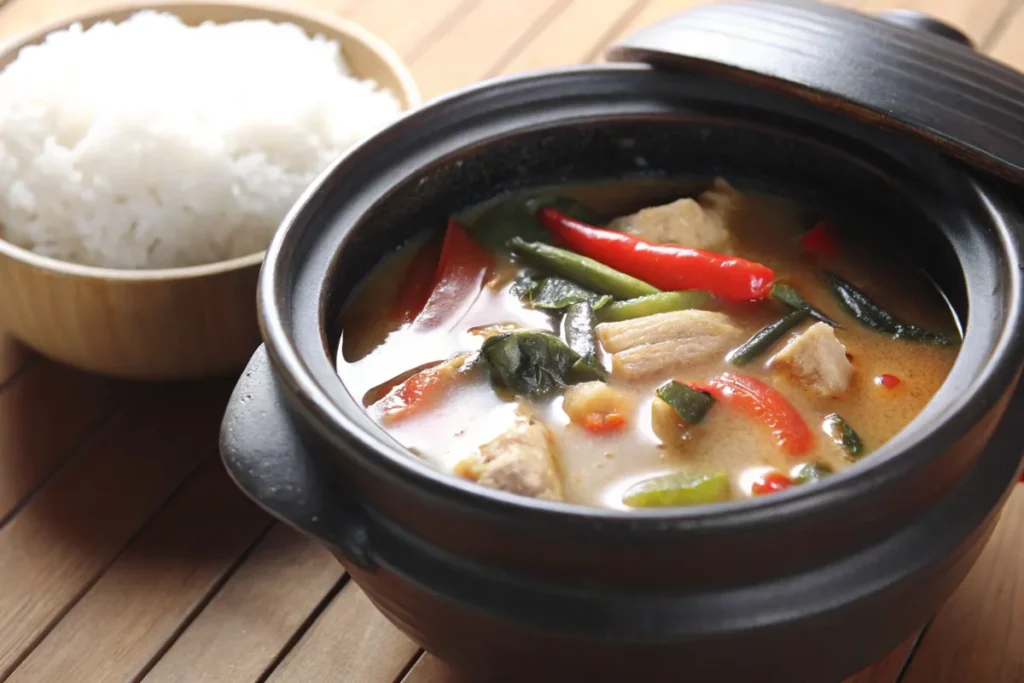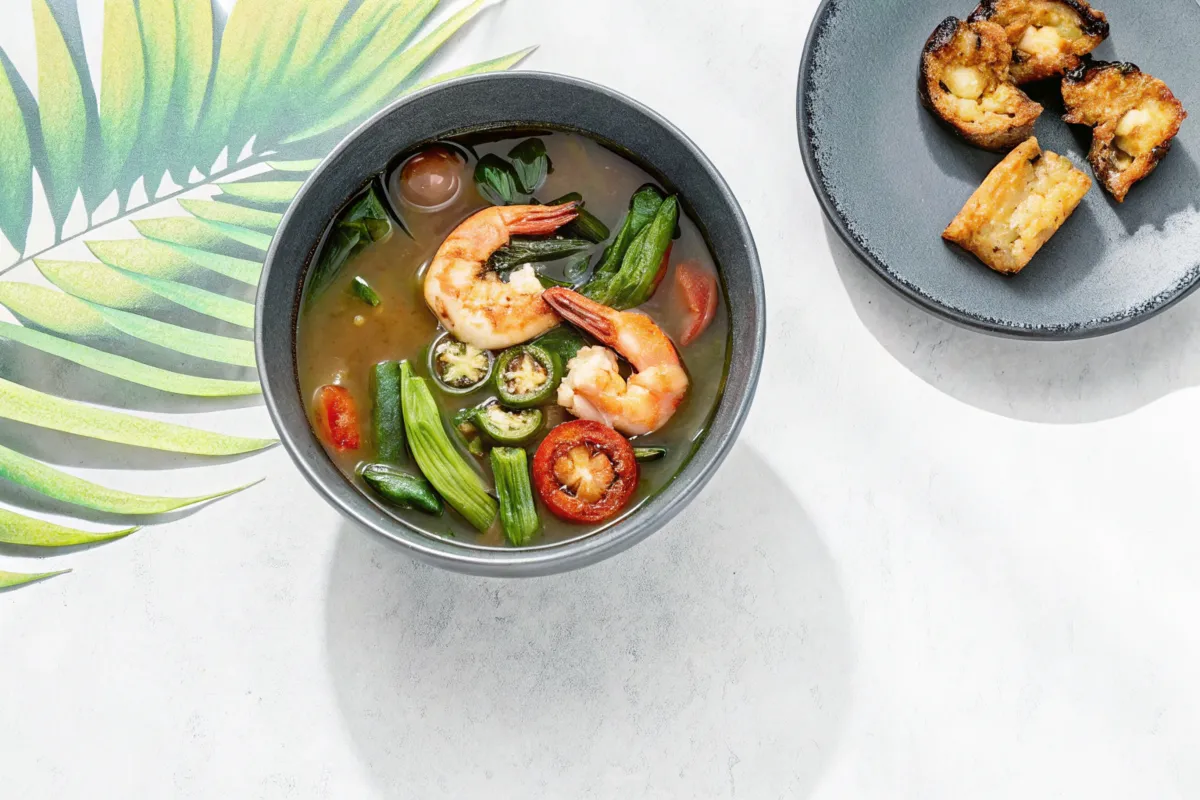Introduction
The Sinigang recipe is one of the most loved dishes in Filipino cooking. First, it is famous for its tangy flavor that comes from tamarind. Then, it combines tender meat, fresh vegetables, and a perfectly sour broth to create a meal everyone can enjoy. Finally, this soup is the perfect comfort food for rainy days, family dinners, or gatherings with friends.
If you have never made Sinigang before, don’t worry! In this guide, we will show you every step. You will learn how to balance the sour and savory flavors, choose the freshest ingredients, and adjust the recipe to fit your taste. Whether you like pork, shrimp, or fish, this Sinigang recipe is easy to customize. By the end of this guide, you’ll know how to prepare this amazing dish and enjoy it with your loved ones.
History and Origins of Sinigang
Sinigang has been part of Filipino culture for many generations. First, its name comes from the Tagalog word sigang, which means “to stew.” Then, this dish became popular because it uses souring agents like tamarind (sampalok), calamansi, and kamias, which were always easy to find in the Philippines. Finally, it became a household favorite because it is simple to prepare and perfect for feeding the whole family.
In the past, people cooked Sinigang with whatever fresh ingredients they had. Some used pork, while others used shrimp, milkfish, or beef. Fresh vegetables, such as kangkong (water spinach), labanos (white radish), and sitaw (string beans), were also added to make the soup more filling. Today, the Sinigang recipe is still loved because it’s delicious, affordable, and healthy. It has even been compared to other sour soups like Thailand’s Tom Yum, but Sinigang stands out with its unique Filipino twist.

Ingredients for Sinigang Recipe
The Sinigang recipe is known for its simple yet flavorful ingredients. First, the tangy soup gets its flavor from tamarind, which is a souring agent. Then, fresh vegetables, tender meat, and savory seasonings are combined to create a perfect balance of taste. Finally, every ingredient works together to make this classic Filipino soup unforgettable.
Main Ingredients
- Protein Options:
- Pork (pork belly, pork ribs, or pork shoulder)
- Shrimp (fresh or frozen)
- Milkfish (bangus) or other firm fish
- Beef (short ribs or brisket)
- Tamarind (Sampalok):
- Tamarind paste, tamarind mix, or fresh tamarind
- Fresh Vegetables:
- Kangkong (water spinach)
- Sitaw (string beans)
- Labanos (white radish)
- Eggplant (optional)
- Okra (optional)
- Tomatoes and onions (for the broth base)
- Seasonings:
- Fish sauce (patis) for an umami kick
- Salt and pepper to taste
- Water or Broth:
- Plain water is traditional, but broth adds richness to the soup’s flavor.
Optional Ingredients and Substitutions
If some ingredients aren’t available, don’t worry! First, you can use calamansi or green mangoes instead of tamarind as a souring agent. Then, chili peppers can add a slight spicy kick for those who love heat. Finally, for vegetarians, tofu or mushrooms can replace the meat, and vegetable broth can be used instead of water.
Tips for Choosing Fresh Ingredients
- For Meat: Choose fresh cuts with some fat to enhance the soup’s flavor. However, if you prefer a leaner option, trim off any excess fat.
- For Vegetables: Always select fresh and crisp produce. For example, avoid wilted greens or soft radishes, as they won’t give the same vibrant taste.
- For Tamarind: Use fresh tamarind for the most authentic flavor, but tamarind paste or powder is great when you’re short on time.

Preparation for Sinigang Recipe
Preparing the Sinigang recipe is easy if you follow these steps. First, it’s important to gather all your ingredients and tools to ensure the cooking process is smooth. Then, you can start by preparing your protein and vegetables. Finally, the sour broth comes together as you combine everything in one pot for a hearty and flavorful meal.
Step 1: Prepare the Protein
- For Pork or Beef:
- First, rinse the meat under cold water to remove any impurities.Then, cut the pork or beef into medium-sized chunks for faster cooking.Finally, blanch the meat in boiling water for 2–3 minutes to remove excess fat and scum.
- For Shrimp or Fish:
- Rinse the seafood thoroughly to remove any dirt or slime.
- Then, devein the shrimp or clean the fish, depending on which protein you are using.
- Finally, keep them in the fridge until you are ready to cook, as seafood cooks quickly.
Step 2: Prep the Vegetables
- Wash and Slice:
- First, rinse all vegetables under running water to remove dirt and debris.
- Then, slice the radish into thin rounds, cut the string beans into 2-inch pieces, and chop the eggplant into bite-sized chunks.
- Finally, set the vegetables aside in separate bowls to keep them organized.
- Prepare the Aromatics:
- Dice the onions and tomatoes, which will form the base of the soup.
- Peel and slice the tamarind or prepare the tamarind paste if you’re using fresh fruit.
- Finally, measure out your fish sauce, salt, and pepper to have them ready for seasoning.
Step 3: Cook the Sinigang
- Sauté the Aromatics:
- First, heat a pot over medium heat and add a tablespoon of oil.
- Then, sauté the onions and tomatoes until they are soft and fragrant.
- Finally, add the meat (if using pork or beef) and cook until lightly browned.
- Add the Broth:
- Pour in water or broth and bring it to a boil.
- Then, lower the heat to simmer and remove any scum that rises to the surface.
- Finally, let the meat cook for 45 minutes to an hour, or until tender.
- Add the Tamarind and Vegetables:
- Stir in the tamarind paste (or fresh tamarind) to infuse the soup with its signature tangy flavor.
- Then, add the radish, string beans, and eggplant, and cook for 5–7 minutes.
- Finally, add the kangkong and okra last, as they only need 2–3 minutes to cook.
- Season the Soup:
- First, taste the broth to check the sourness.
- Then, adjust the flavor by adding fish sauce, salt, or pepper.
- Finally, let the soup simmer for another 2 minutes to ensure all the flavors blend well.

Final Step: Serve Your Sinigang
Once the soup is cooked, transfer it to a large serving bowl. Then, garnish it with a few fresh leaves of kangkong or slices of chili pepper for an extra touch of flavor. Finally, serve your Sinigang recipe hot with a side of steamed rice, which balances the soup’s tangy taste perfectly.
Key Tips for Cooking Sinigang
- For the Best Flavor: Use fresh tamarind whenever possible, as it gives a richer and more authentic sourness.
- For Faster Cooking: If you’re short on time, use a pressure cooker to tenderize the meat quickly.
- For Vegetarian Options: Add mushrooms and tofu in place of meat, and use vegetable broth to keep the dish plant-based.
Cooking and Serving the Sinigang Recipe
Now that your soup is ready, it’s time to focus on the final steps. First, we’ll ensure your Sinigang recipe is perfectly cooked by checking the flavors and consistency. Then, we’ll discuss how to plate and serve the dish to make it even more inviting. Finally, we’ll recommend side dishes that go well with Sinigang to complete your meal.
Step 1: Final Check
- Taste the Broth:
- First, take a small sip of the broth to check the balance of flavors.
- Then, if it needs more sourness, add a bit more tamarind paste or fresh tamarind.
- Finally, adjust the saltiness by adding a splash of fish sauce or a pinch of salt.
- Check the Texture:
- Make sure the meat is tender enough to be easily pulled apart with a fork.
- Then, ensure the vegetables are cooked just right—soft but not mushy.
- Finally, stir the soup gently to mix all the ingredients evenly before serving.
Step 2: Plating and Serving
- Transfer the Soup:
- First, pour the hot Sinigang into a large, deep serving bowl.
- Then, arrange the vegetables on top so they’re visible and appealing.
- Finally, garnish with fresh kangkong leaves or a slice of red chili for a pop of color.
- Serve with Rice:
- Always pair Sinigang with steamed white rice.
- Place the rice on individual plates or in bowls so each person can control how much broth they want to add.
- Encourage diners to mix the rice and soup for the best flavor experience.
- Optional Garnishes:
- Add extra tamarind paste on the side for those who love a tangier soup.
- Serve fish sauce with chopped chili for an extra layer of heat and saltiness.
- Offer calamansi slices for a burst of fresh citrus flavor.
Best Side Dishes to Serve with Sinigang
- Fried Fish or Shrimp:
- Crispy fried fish or shrimp adds a crunchy texture that complements the tangy soup.
- Salted Egg and Tomato Salad:
- This classic Filipino side dish provides a creamy and slightly salty flavor to balance the sour broth.
- Vegetable Lumpia (Spring Rolls):
- Pair the soup with fried lumpia for a combination of light and crunchy textures.
Tips for Storing Leftovers
- Cool the Soup Properly:
- Let the Sinigang cool to room temperature before storing it in the fridge.
- Use Airtight Containers:
- Store the soup in an airtight container to keep it fresh for up to 3 days.
- Reheat Gently:
- Reheat the soup on low heat to avoid overcooking the vegetables.
Variations and Customizations of the Sinigang Recipe
One of the best things about the Sinigang recipe is its versatility. First, you can adjust the protein to suit your preferences. Then, you can swap vegetables based on what’s available in your area. Finally, you can modify the broth’s flavor to make it spicier, tangier, or even vegetarian. Below are some exciting variations and customizations you can try.
Regional Variations
- Sinigang na Baboy (Pork Sinigang):
- This is the most traditional version of the Sinigang recipe and uses pork belly or ribs for a rich, hearty flavor.
- Sinigang na Hipon (Shrimp Sinigang):
- Instead of pork, this version uses shrimp, making it a lighter yet equally delicious dish.
- Sinigang na Bangus (Milkfish Sinigang):
- Popular in coastal regions, this dish uses milkfish (bangus) for a healthy, omega-3-rich twist.
- Beef Sinigang:
- This version features tender beef short ribs or brisket, giving the soup a bold and hearty taste.
Dietary Modifications
- Vegetarian Sinigang:
- Skip the meat entirely and use tofu or mushrooms as the main protein.
- Use vegetable broth instead of water for a flavorful plant-based version.
- Low-Sodium Option:
- Reduce the amount of fish sauce or replace it with a low-sodium soy sauce.
- Add more fresh vegetables to increase the soup’s natural flavor without extra salt.
- Spicy Sinigang:
- Add red chili peppers or a spoonful of chili oil for a spicier broth.
- Serve with chili-infused fish sauce for an extra kick.
Creative Twists
- Coconut Sinigang:
- Add a splash of coconut milk to the broth for a creamy and slightly sweet twist on the classic soup.
- Roasted Tamarind:
- For a deeper and smokier flavor, roast the tamarind before adding it to the broth.
- Fusion Sinigang:
- Use unconventional proteins like salmon, chicken, or even duck to give the soup a modern twist.
How to Enhance the Flavor
- Double the Tamarind:
- If you love a tangy broth, add more tamarind paste or fresh tamarind pulp.
- Fresh Herbs:
- Sprinkle fresh cilantro or parsley on top for a refreshing finish.
- Fermented Options:
- Try adding fermented shrimp paste (bagoong) for a unique depth of flavor.
Serving Suggestions for the Sinigang Recipe
The Sinigang recipe is best enjoyed fresh and piping hot. First, serving this tangy Filipino soup with the right accompaniments enhances its flavors. Then, adding creative garnishes makes the dish more appealing and personal. Finally, pairing Sinigang with side dishes like rice or fried fish completes the meal. Below are some serving tips and ideas to make your Sinigang unforgettable.
How to Plate and Serve Sinigang
- Use a Large Serving Bowl:
- First, ladle the Sinigang into a deep serving bowl to keep the broth warm.
- Then, arrange the vegetables and meat on top to make the presentation more vibrant.
- Finally, add garnishes like fresh kangkong leaves or a slice of red chili for a pop of color.
- Individual Bowls for Serving:
- Serve Sinigang in smaller bowls for each person.
- Pour enough broth to cover the rice or leave the rice separate, depending on preference.
- Always place extra soup on the table so diners can refill their bowls if they want more.
Side Dishes to Pair with Sinigang
- Steamed White Rice:
- The most classic pairing for the Sinigang recipe, rice soaks up the flavorful broth and balances the tangy taste.
- Fried Fish or Shrimp:
- A crispy side dish like fried tilapia, bangus, or shrimp adds texture and complements the sour soup.
- Grilled Eggplant with Bagoong:
- The smoky flavor of grilled eggplant and the saltiness of fermented shrimp paste pair perfectly with the Sinigang broth.
- Salted Egg and Tomato Salad:
- This simple side dish of sliced salted eggs and tomatoes balances the tanginess of Sinigang with its creamy and salty notes.
Garnishes for Extra Flavor
- Chopped Red Chili:
- Sprinkle chopped red chili for a spicy twist.
- Place a small dish of chili-infused fish sauce on the side for diners who like more heat.
- Fresh Calamansi or Lemon Slices:
- Add a slice of calamansi or lemon for a fresh citrus aroma.
- Squeezing a little juice over the soup enhances the tangy flavor even further.
- Crispy Garlic Toppings:
- Fry minced garlic until golden brown, then sprinkle it over the soup before serving.
Presentation Tips
- Use Colorful Vegetables:
- Choose vegetables like tomatoes, string beans, and eggplant for a vibrant look. The colors will make the dish more appetizing.
- Serve in Traditional Bowls:
- Use Filipino-style clay pots or large ceramic bowls to give the dish a rustic, authentic feel.
- Add Fresh Herbs:
- Garnish with fresh parsley, cilantro, or scallions to add a touch of green and enhance the presentation.
Nutritional Analysis of the Sinigang Recipe
The Sinigang recipe is both tasty and nutritious. First, it includes fresh vegetables that are packed with vitamins and minerals. Then, it offers a great source of protein from the meat or seafood you choose. Finally, the tamarind-based broth is light, low in calories, and rich in antioxidants, making it a perfect addition to any meal.
Health Benefits of Sinigang
- Rich in Vitamins and Minerals:
- Vegetables like kangkong, labanos, and tomatoes provide important nutrients. For example, they are excellent sources of vitamin A, vitamin C, and potassium. Additionally, tamarind is full of antioxidants, which can help improve digestion and boost overall health.
- High in Protein:
- Depending on your protein choice, Sinigang can provide plenty of muscle-building nutrients. For example, pork, shrimp, and fish are great options for adding protein to your diet. Furthermore, fish like bangus includes omega-3 fatty acids, which are known to improve heart health.
- Low in Fat (With Adjustments):
- If you trim excess pork fat or use leaner proteins like shrimp or fish, the soup becomes a low-fat meal. Additionally, replacing pork with tofu is a healthy alternative for those on a vegetarian diet.
- Low in Calories:
- Because the broth is water-based and uses very little oil, Sinigang is naturally low in calories. Moreover, its tangy flavor keeps it light and refreshing while still being filling and satisfying.
Nutritional Table (Per Serving for Pork Sinigang – Approximate Values)
| Nutrient | Amount Per Serving |
|---|---|
| Calories | 250 kcal |
| Protein | 20 g |
| Fat | 10 g |
| Carbohydrates | 15 g |
| Fiber | 5 g |
| Vitamin C | 35% of Daily Value |
| Potassium | 20% of Daily Value |
| Sodium | 800 mg |
Tips for Making Sinigang Healthier
- Choose Leaner Cuts of Meat:
- First, opt for lean pork cuts like tenderloin instead of fatty pork belly. Then, you can also try chicken breast for a lighter and healthier version. Finally, shrimp or fish are naturally leaner options that reduce fat without sacrificing flavor.
- Reduce Sodium:
- To control sodium levels, use less fish sauce and balance the flavor with fresh calamansi or tamarind instead. Additionally, you can season the soup with herbs like parsley or cilantro for added freshness.
- Add More Vegetables:
- For a more nutrient-dense soup, double the amount of kangkong, labanos, or okra. Furthermore, vegetables make the soup more filling without adding extra calories.
- Use Vegetable Broth:
- Instead of plain water, you can use vegetable broth for extra flavor. Additionally, vegetable broth is ideal for vegetarian versions of the Sinigang recipe, as it adds richness without meat.
- Avoid Overcooking Vegetables:
- Always cook vegetables just until they are tender. For example, leafy greens like kangkong cook faster and should be added last. Finally, remove the soup from the heat as soon as the vegetables are done to retain their nutrients.
Why Sinigang is a Healthy Choice
The Sinigang recipe is an excellent choice for anyone looking for a healthy and balanced meal. First, it combines protein from meat or seafood with fiber-rich vegetables to create a nutritious dish. Then, its light and tangy broth is low in fat, making it perfect for weight-conscious individuals. Finally, because the recipe is so customizable, you can easily adjust the ingredients to fit your dietary preferences. For example, you can make it vegetarian, low-sodium, or even spicier depending on your needs. Whether you’re trying to eat healthy or just craving comfort food, Sinigang is always a great option.
FAQs About Sinigang Recipe
Here are answers to the most frequently asked questions about Sinigang, including details about its ingredients, preparation, and health benefits.
The main ingredients of a traditional Sinigang recipe include:
Protein: Pork, shrimp, milkfish (bangus), or beef
Vegetables: Kangkong (water spinach), labanos (white radish), sitaw (string beans), tomatoes, and eggplant
Souring Agent: Tamarind (sampalok), calamansi, or green mango
Seasonings: Fish sauce, salt, and pepper
These ingredients create the sour and savory flavors that make Sinigang a beloved Filipino dish.
Yes, Sinigang is considered a healthy dish because:
It includes fresh vegetables that are rich in vitamins and fiber.
Proteins like shrimp or fish provide lean, low-fat options.
The broth is tamarind-based and low in calories, making it light and hydrating.
To make Sinigang even healthier, you can reduce the fish sauce for lower sodium content and add more vegetables for extra nutrients.
Sinigang mix typically contains powdered tamarind extract, salt, sugar, and artificial flavor enhancers. Some brands may also include dried onions, garlic, and tomatoes to replicate the flavors of a freshly made broth.
To reduce bitterness in Sinigang:
Rinse your tamarind or souring agent thoroughly before cooking.
Avoid overcooking vegetables like eggplant, which can release a bitter taste.
Add a teaspoon of sugar to balance the flavors if needed.
Sinigang is often referred to as “sour soup” in English. However, there is no direct translation because it is a uniquely Filipino dish with a distinct flavor profile.
Conclusion
Sinigang is more than just a soup; it’s a reflection of Filipino culture and tradition, offering comfort and nourishment in every bowl. Its unique blend of tangy, savory, and earthy flavors makes it a timeless dish loved by many. Whether you prepare it with pork, shrimp, or milkfish, the Sinigang recipe is versatile and can be adapted to suit your taste and dietary preferences.
Tips for the Perfect Sinigang
1. Use Fresh Ingredients
- Always choose fresh vegetables and proteins to ensure a vibrant and flavorful soup.
2. Balance the Flavors
- Taste the broth as you go. If it’s too sour, add a pinch of sugar. If it needs more tang, adjust with tamarind or calamansi.
3. Don’t Overcook the Vegetables
- Add tender greens like kangkong or okra last to keep their texture and nutrients intact.
4. Customize to Your Preference
- Experiment with proteins like chicken, tofu, or salmon to create your own twist on the traditional Sinigang.
5. Serve Hot with Rice
- Sinigang is best enjoyed fresh and steaming hot, paired with a side of warm, fluffy rice.
By following these tips, you can make Sinigang not only delicious but also a dish that reflects your personal style. So, gather your ingredients, take your time, and enjoy the process of creating this Filipino culinary masterpiece.
Ready to Cook?
Then, explore a world of creative and delicious recipes on QuicklyTasty.com . In addition, you’ll find related articles filled with cooking tips, recipe guides, and inspiration for your next culinary adventure. Moreover, if you’d like more personalized suggestions, let me know! I can help you discover unique ideas, refine your techniques, or plan the perfect meal. Ultimately, the possibilities are endless.
Thank you for reading, and happy cooking!

